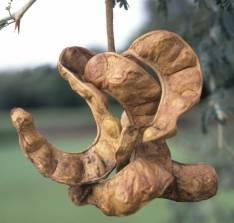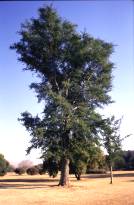Faidherbia albida
Faidherbia albida (Delile) A.Chev.
Family: Fabaceae
Common names: ana tree (Eng.); anaboom (Afr.); mogabo (Sepedi); mokosho (Setswana); umHlalankwazi (IsiZulu); muhoto (Venda)
SA Tree No: 159
Introduction
This relatively drought-resistant tree makes an interesting specimen if planted in a park. It can survive occasional frost (up to 5 days per year).

Description
Description
Faidherbia albida is one of the fastest growing indigenous trees. It is deciduous and can grow up to 30 m tall. It has branching stems and an erect to roundish crown. Greenish grey to whitish grey colour and smoothness is evident on the young stems, but grey and smooth to rough on older branches and stems. The straight, whitish thorns, which are in pairs, are up to 40 mm long.

Pale grey-green leaves which are twice-compound, have a conspicuous gland at the base of each pair of pinnae (leaflets).
Scented, pale cream-coloured flowers form an elongated spike up to 35-160 x 20 mm. The flowers show from March to September, followed by fruit from September to December. The fruit is orange to red-brown in colour, non-splitting and curved to twisted pod. The size of the pods fruit ranges from 100-350 x 20-50 mm. The seeds are mostly eaten by Brown Playboy butterfly larvae.

Conservation Status
Status
The ana tree is one of the protected trees in South Africa.
Distribution and habitat
Distribution description
This tree's distribution is from Israel in the north to Kwazulu-Natal in the south. It grows in waterlogged soils along rivers, swamps, floodplains and dry river courses.
Derivation of name and historical aspects
History
Albida means somewhat white, and refers to the whitish stem of the ana tree.
Ecology
Ecology
Uses
Use

In the landscape, it can make an interesting specimen when planted in a park or a big garden. The ana tree has an extensive root system and can be planted close together in rows in a contour to stabilize eroded soils.
It is a valuable fodder tree for game and domestic animals. It is mostly browsed by, elephants, giraffe, kudu, nyala, and impala. This plant loses its leaves in summer, thus providing fodder during the winter. The leaves are nutritious; the seeds have high protein content, and the pods are high in starch.
It can be planted in groups of ten to twelve scattered in the veld to provide fodder.
The seeds can be boiled and eaten, but first the skin has to be removed. Also the pods may be dried and ground into flour, which is edible. Again, the pods are said to have been used as fish poison. In Namibia, strips of bark are used as dental floss.
The ana tree can also be used medicinally. A decoction of the bark is used to treat diarrhoea, bleeding and inflamed eyes. It can be used as an emetic as well.
Growing Faidherbia albida
Grow
Faidherbia is one of the acacias. Its seeds need to be treated with boiling water before sowing. The seeds can be immersed in hot water overnight. Select swollen seeds, they are the ones that are viable (are able to germinate) and sow them in river sand. Seeds must not be buried deep, but must be covered with a layer of sand the same size as the seeds.
The seeds usually germinate after two to five days. The seedling develops a long taproot and must be transplanted directly into the garden. The correct time to transplant the seedlings is when they have reached a height of 50 mm. Caution must be taken to protect young plants from frost.
Young trees are mostly attacked by white Australian bug. They can be treated with systemic (absorbed by the plant system) insecticides.
References
- Coates Palgrave, M. 2002. Keith Coates Palgrave Trees of southern Africa, edn 3. Struik, Cape Town.
- Joffe, P. 2001. Creative gardening with indigenous plants. Briza Publications, Pretoria.
- Van Wyk, A.E. & Van Wyk,P. 2001. Field guide to trees of southern Africa. Struik, Cape Town.
- Venter, F. & Venter, J. 1996. Making the most of indigenous trees. Briza Publications, Pretoria.
Credits
Joseph Aobakwe Difoloko
Pretoria National Botanical Garden
June 2005
Plant Attributes:
Plant Type: Tree
SA Distribution: KwaZulu-Natal, Limpopo, Mpumalanga
Soil type: Clay, Loam
Flowering season: Spring, Winter
PH: Alkaline, Neutral
Flower colour: White, Cream
Aspect: Full Sun
Gardening skill: Easy
Special Features:
Horticultural zones








Rate this article
Article well written and informative
Rate this plant
Is this an interesting plant?
Login to add your Comment
Back to topNot registered yet? Click here to register.